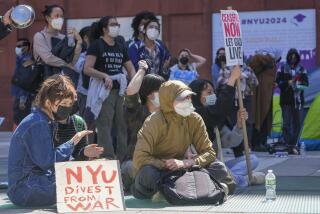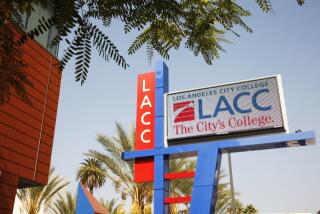NYU Earns Respect by Buying It
NEW YORK — Strip away tradition, ivy-covered walls, fancy laboratories, gray-muzzled scholars and what’s left at the foundation of all great universities is the same thing: money.
That’s the stuff that made Harvard, Yale and Princeton great over the past couple of hundred years. It’s what Stanford spent lavishly in the ‘60s to build a world-class faculty and its reputation.
And it is the stuff that in a relatively short time has transformed New York University from a mediocre commuter school into one of the nation’s premier private universities--one with enough allure to attract thousands of students from California each year.
NYU’s make-over is emblematic of a resurging interest in urban education nationwide that has come with falling crime rates and a shift in what students want out of college.
For other urban universities trying to rise into the top tier--USC, for example--NYU’s success is also a powerful challenge to conventional wisdom about how to manage money.
Unlike competitors that squirrel away money in endowments and live off the interest, NYU has taken the $2 billion it has raised in private donations since the late 1970s and gone on a Manhattan-style spending spree.
The school has spent about 85% of the money it has raised, putting only 15% in its endowment. By contrast, USC, a comparable institution in many ways, has saved about half of the $1.5 billion it has raised in its current fund-raising campaign.
NYU’s endowment stands at about $1 billion. USC’s is nearly double that amount.
But in exchange, NYU has enticed top-notch professors from Ivy League and other elite institutions with lucrative offers--often including subsidized apartments in expensive Manhattan neighborhoods. It has tossed about scholarships to attract ultra-bright students. It has cobbled together a new urban campus in artsy Greenwich Village.
“We’ve simply done in 20 years what it took other universities a hundred and fifty years to do,” said L. Jay Oliva, NYU’s president. “There’s no way to get excellence, other than buying your way into it.”
Other academics have watched with a mixture of envy and astonishment as NYU has broken all the conventions that keep university money managers a tightfisted bunch.
To some degree, NYU has upped the ante for university leaders who rejoice at their ever-growing nest eggs, yet at the same time tell faculty to scrounge for their own research dollars and students to pay ever-spiraling tuition.
Professors and other academics increasingly point to NYU’s success as an example to bolster the argument that universities ought to spend more today rather than save for tomorrow.
Rules Dictate University Spending
Does Harvard really need a $14-billion endowment? Does Yale need $7 billion? Do Princeton or Stanford need $6 billion?
Universities slavishly follow rules to spend only a fixed percentage of their endowments--usually between 3.5% and 5.5%--based on the endowment’s earnings. So even in the best of times, the biggest endowments provide less than 10% and more often less than 5% of the $1 billion-plus a year needed to run a major university.
Henry Hansmann, a Yale law professor who has studied college endowments, believes that all the hoarding diverts universities from their core mission of educating students and making breakthroughs in science and other fields.
“They can contribute more to society by building a great university than they can by building a great endowment,” he said. “Yet it’s as if universities were set up to maintain a steady growth investment fund and run an educational institution on the side.”
Administrators at other colleges are critical of NYU’s free-spending practices. They say NYU largely missed the bull market of the 1990s by managing its relatively small endowment too conservatively. And they often bring up the folk tale of the grasshopper and the ant. NYU is foolishly consuming everything now, while they are industriously saving for leaner times, the critics say.
“Most people think it’s a pretty risky strategy,” said Morton Owen Schapiro, a higher education economist and USC vice president. “There’s a lot more security when you have a big endowment, especially in the next economic downturn.”
Yet stockpiled cash rarely gets used in downturns. Instead, when the economy slows, universities generally cut education and research programs to make sure the hard times don’t threaten the portfolio.
Hansmann and his allies argue that administrators are wrongly making a fetish of the size of their universities’ endowments.
“Saving is worthwhile only if you have a better use for the money in the future than you do now. I’m not sure NYU would be a better university if it saved more money instead of hiring better faculty, luring better students and building more buildings,” Hansmann said.
That way of thinking has won some converts.
“There is a bit of push back,” said Trish Jackson, a vice president of the Council for Advancement and Support of Education. She hears more self-examining questions: “How can we justify endowments over $1 billion? Are we shortchanging today’s students for tomorrow’s students?”
By all accounts, NYU’s approach has brought great success.
A record 30,750 students applied this year to join next fall’s freshman class. With only 3,450 freshman seats, NYU has become one of the most popular and highly selective institutions in the country. It charges nearly as much as the Ivies, too: $23,456 in tuition, with total cost of attendance--including room, board and books--estimated at $33,582.
Groups of eager teenagers line up daily for tours. Yet a campus tour here differs from those at most schools because, well, there is no actual campus.
Tour guides must act like traffic cops as they escort their groups across busy intersections on a walking tour of the university’s buildings, scattered around Greenwich Village.
NYU has evolved into an ultra-urban setting for its students--a departure from Thomas Jefferson’s vision of a pastoral campus with stately buildings laid out in geometric symmetry around a grassy quad.
The main library and administration building sits across from Washington Square Park. A building of classrooms is nearby. Dorms are around the corner and several blocks away.
The scene is a familiar backdrop to teenagers across America who watch “Felicity”--a hit TV show about a “University of New York” sophomore who learns about love and life in the big city.
NYU benefits handsomely from the show, which has recast its neighborhood into a romantic spot. Morgan Moses-Allen, 17, visiting the campus from Baltimore, said she watches faithfully. “After I saw the show, I thought, ‘Ooh, New York.’ It made the place more exciting.”
Even without the extra buzz from television, NYU’s setting is attractive to today’s students--who, as a group, are more practical and career-oriented than their predecessors--but still want to have fun. They prefer the excitement of the big city and proximity to a wide array of internships that may lead to jobs.
Other urban campuses, including USC, Columbia and the universities of Chicago and Pennsylvania, have also seen their applications swell.
NYU also has been lucky to reap the benefits of New York City’s renaissance, from the model of urban crime and decay to a thriving metropolis.
To some degree, though, NYU has made its own luck.
NYU Spreads Into Community
Instead of walling itself off from its surroundings as many universities do, NYU spread into the community. It gambled by building high-rise dorms in neighborhoods that were so shaky they made administrators nervous.
Instead of catastrophe, the infusion of thousands of college students stabilized the area, said NYU Dean David Finney. “A bunch of shops and buildings that were vacant were suddenly rented. Restaurants, movie theaters and other business began to move in.”
Some students now complain that the Village has lost its edge--a complaint that delights security-conscious administrators.
“It has become a lot less gritty and safer, which is great,” said Cami Carter, a senior majoring in musical theater. “But it ruins the image of the bohemian lifestyle.”
NYU’s transformation is all the more remarkable given that the school teetered on the brink of bankruptcy in the ‘70s.
When it hit bottom, NYU couldn’t meet payroll. It laid off junior faculty and nudged older ones into early retirement. It closed its engineering school and sold its main undergraduate campus in the Bronx to the City University of New York.
The near-death experience seemed to free university leaders from the fiscal constraints that dominate most campuses, said President Oliva, who was dean of the University Heights campus when it was sold.
“The question was,” Oliva said, “what are we going to do? Lapse into a third-rate university or go for the higher ground.”
The university’s trustees decided to go for broke.
“It made good business sense,” said Laurence A. Tisch, the former CBS chairman and billionaire investor who led NYU’s board of trustees for two decades. “We had to spend the money to get where we wanted to be, as opposed to putting it away for the future.”
NYU embarked on a $1-billion fund-raising campaign in 1984 and reached its goal earlier than predicted because donors were enthusiastic about their gifts’ helping rebuild the university.
As it has spent its way to the top, the university has carefully selected its academic niche, building spires of excellence in some fields, and conspicuously not in others.
It has generally avoided dishing out the obscene piles of cash needed to be competitive in the top tier in the experimental sciences: biology, physics, chemistry. Instead, it has made its mark in the arts, humanities and some select areas in the social sciences and hard sciences.
It has built a renowned law school, one whose professors were perennially ranked as the highest paid in the nation until last year, when NYU quit participating in the Society of American Law Teachers’ annual survey.
It has well-regarded centers in mathematics, computer science and neuroscience, which studies the workings of the human brain. It has highly ranked schools of law and performing arts, as well as departments of philosophy, English, French, Italian, comparative literature, anthropology, sociology and economics.
All the academic acclaim has turned NYU into a destination for students around the country. So many Californians attend NYU that the state is the third-largest feeder of students behind New York and New Jersey. Last year, NYU was the No. 1 destination of seniors from Crossroads School for Arts & Sciences, a trendy Santa Monica prep school.
Jonathan Cole, provost and chief academic officer at Columbia, pays NYU perhaps the highest compliment possible for someone from the uptown Ivy League institution: “NYU is creeping into the group of institutions that are competing for talent. Occasionally we find ourselves in competition with NYU.”
More than he would like to admit, says Stanley O. Ikenberry, president of the American Council on Education, the trade group of the nation’s biggest research universities.
“Every day NYU goes out to see how it can eat Columbia’s lunch and vice versa,” Ikenberry said. “They are both stronger for it.”
USC President Steven B. Sample also has been impressed by NYU’s rapid success. He recently told his faculty that it’s time for USC “to emphasize the endowment a bit less” and spend more on new buildings.
“I think NYU is a fine university and has done some very, very fine things,” Sample said in an interview. “There’s something to be learned there. . . . It may turn out that 50 years from now, that we, like everybody else, should have been spending our money instead of saving it.”
(BEGIN TEXT OF INFOBOX / INFOGRAPHIC)
NYU’s Rising Fortunes
Bouncing back from near bankruptcy in 1973, New York University coffers have been infused with more than
$2 billion in donations. Unlike most universities, NYU has spent--rather than saved--most of the money to
fuel its ambitious campaign to erect buildings, hire faculty and attract students. *
*
Investment Payoff
The number of students applying each year for undergraduate programs has grown as NYU has become a “hot” school. As applications have soared, NYU has become more choosy about the students it selects.
*
SAT Scores
As NYU has become more selective, it has attracted better-prepared students. Average combined math and verbal SAT scores for incoming freshmen: *
*
Source: New York University
(BEGIN TEXT OF INFOBOX / INFOGRAPHIC)
NYU’s Ultra Urban Experience
*
Unlike the usual college campus with its verdant, leafy grounds, New York University’s buildings are scattered throughout Greenwich Village.
More to Read
Sign up for Essential California
The most important California stories and recommendations in your inbox every morning.
You may occasionally receive promotional content from the Los Angeles Times.










